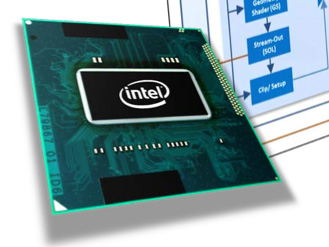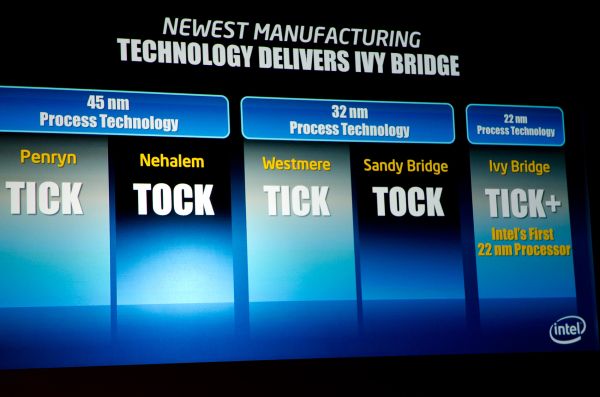The Ivy Bridge Preview: Core i7 3770K Tested
by Anand Lal Shimpi on March 6, 2012 8:16 PM EST- Posted in
- CPUs
- Intel
- Core i7
- Ivy Bridge
Note: This preview was not sanctioned or supported by Intel in any way.
I still remember hearing about Intel's tick-tock cadence and not having much faith that the company could pull it off. Granted Intel hasn't given us a new chip every 12 months on the dot, but more or less there's something new every year. Every year we either get a new architecture on an established process node (tock), or a derivative architecture on a new process node (tick). The table below summarizes what we've seen since Intel adopted the strategy:
| Intel's Tick-Tock Cadence | |||||
| Microarchitecture | Process Node | Tick or Tock | Release Year | ||
| Conroe/Merom | 65nm | Tock | 2006 | ||
| Penryn | 45nm | Tick | 2007 | ||
| Nehalem | 45nm | Tock | 2008 | ||
| Westmere | 32nm | Tick | 2010 | ||
| Sandy Bridge | 32nm | Tock | 2011 | ||
| Ivy Bridge | 22nm | Tick | 2012 | ||
| Haswell | 22nm | Tock | 2013 | ||
Last year was a big one. Sandy Bridge brought a Conroe-like increase in performance across the board thanks to a massive re-plumbing of Intel's out-of-order execution engine and other significant changes to the microarchitecture. If you remember Conroe (the first Core 2 architecture), what followed it was a relatively mild upgrade called Penryn that gave you a little bit in the way of performance and dropped power consumption at the same time.

Ivy Bridge, the tick that follows Sandy Bridge, would typically be just that: a mild upgrade that inched performance ahead while dropping power consumption. Intel's microprocessor ticks are usually very conservative on the architecture side, which limits the performance improvement. Being less risky on the architecture allows Intel to focus more on working out the kinks in its next process node, in turn delivering some amount of tangible power reduction.
Where Ivy Bridge shakes things up is on the graphics side. For years Intel has been able to ship substandard graphics in its chipsets based on the principle that only gamers needed real GPUs and Windows ran just fine on integrated graphics. Over the past decade that philosophy required adjustment. First it was HD video decode acceleration, then GPU accelerated user interfaces and, more recently, GPU computing applications. Intel eventually committed to taking GPU performance (and driver quality) seriously, setting out on a path to significantly improve its GPUs.
As Ivy is a tick in Intel's cadence, we shouldn't see much of a performance improvement. On the CPU side that's mostly true. You can expect a 5 - 15% increase in performance for the same price as a Sandy Bridge CPU today. A continued desire to be aggressive on the GPU front however puts Intel in a tough spot. Moving to a new manufacturing process, especially one as dramatically different as Intel's 22nm 3D tri-gate node isn't easy. Any additional complexity outside of the new process simply puts schedule at risk. That being said, its GPUs continue to lag significantly behind AMD and more importantly, they still aren't fast enough by customer standards.
Apple has been pushing Intel for faster graphics for years, having no issues with including discrete GPUs across its lineup or even prioritizing GPU over CPU upgrades. Intel's exclusivity agreement with Apple expired around Nehalem, meaning every design win can easily be lost if the fit isn't right.
With Haswell, Intel will finally deliver what Apple and other customers have been asking for on the GPU front. Until then Intel had to do something to move performance forward. A simple tick wouldn't cut it.

Intel calls Ivy Bridge a tick+. While CPU performance steps forward, GPU performance sees a more significant improvement - in the 20 - 50% range. The magnitude of improvement on the GPU side is more consistent with what you'd expect from a tock. The combination of a CPU tick and a GPU tock is how Intel arrives at the tick+ naming. I'm personally curious to see how this unfolds going forward. Will GPU and CPUs go through alternating tocks or will Intel try to synchronize them? Do we see innovation on one side slow down as the other increases? Does tick-tock remain on a two year cadence now that there are two fairly different architectures that need updating? These are questions I don't know that we'll see answers to until after Haswell. For now, let's focus on Ivy Bridge.










195 Comments
View All Comments
taltamir - Monday, March 12, 2012 - link
Rarson is correct.He isn't suggesting no IGP at all. He is saying put a good IGP on the lower end.
While there ARE people who need a powerful CPU and will not get a video card because they don't play games, those people do not in any way benefit from having a higher end IGP.
High end gamers = discreete GPU + Powerful CPU
Budget gamers = IGP + mid-low range CPU
Non gamers with money = High end CPU + IGP (underused)
Non gamers on a budget = Mid-low range CPU + IGP (underused)
The only people who need a more powerful GPU are the budget gamers and thus it makes sense on the lower end CPUs to have a more powerful IGP.
Urillusion17 - Monday, March 12, 2012 - link
Great article but.... where are the temps??? The few benches I have seen don't mention overclocking, and if they do, they do not mention temps. I am hearing this chip can boil water! I would think that would be as important as anything else...DrWattsOn - Tuesday, March 13, 2012 - link
+1 (very much in agreement)boogerlad - Wednesday, March 14, 2012 - link
is it possible to fully load the igp with an opencl application, and not affect the cpu performance at all? From what I've read, it appears the igp shares the cache with the cpu, so will that affect performance?rocker123 - Monday, March 19, 2012 - link
Generational performance improvements on the CPU side generally fall in the 20 - 40% range. As you've just seen, Ivy Bridge offers a 7 - 15% increase in CPU performance over Sandy Bridge - making it a bonafide tick from a CPU perspectiveShould be :Generational performance improvements on the GPU side generally fall in the 20 - 40% range
rocker123 - Monday, March 19, 2012 - link
Generational performance improvements on the CPU side generally fall in the 20 - 40% range. As you've just seen, Ivy Bridge offers a 7 - 15% increase in CPU performance over Sandy Bridge - making it a bonafide tick from a CPU perspectiveShould be :Generational performance improvements on the GPU side generally fall in the 20 - 40% range
tipoo - Monday, March 19, 2012 - link
They give the drivers their own tweaks and bug fixes, but I doubt they could do something like add T&L without the manufacturers support. In fact, they didn't, unless they have bigger driver teams now.ClagMaster - Wednesday, March 21, 2012 - link
"Personally, I want more and I suspect that Haswell will deliver much of that. It is worth pointing out that Intel is progressing at a faster rate than the discrete GPU industry at this point. Admittedly the gap is downright huge, but from what I've heard even the significant gains we're seeing here with Ivy will pale in comparison to what Haswell provides."Personally, I believe on-board graphics will never be on par with a dedicated graphics part. And it is obcessive-compulsive ridiculous to compare the performance of the HD4000 with discrete graphics and complain its not as good.
The HD4000 is meant for providing graphics for business and multi-media computers. And for that purpose it is outstanding.
If you want gaming or engineering workstation performance, get a discrete graphics card. And stop angsting about how bad onboard graphics is to discrete graphics.
pottermd - Thursday, March 22, 2012 - link
Today's desktop processors are more than fast enough to do professional level 3D rendering at home.The article contained this statement. It's not really true. I've had a long nap and the render I'm doing is still running. :)
Dracusis - Friday, April 6, 2012 - link
"The people who need integrated graphics"No one *needs* integrated graphics. But not everyone needs discrete graphics. The higher performance an IGP has, the less people overall will *need* DGPs.
Not all games need dedicated graphics cards, just the multi million dollar re-hashed COD's that choke retail stores. There are literally thousands of other games around that only require a small amount of graphics processing power. Flash now has 3D accelerated content and almost every developer using it will target IGP performance levels. Almost all casual game developers target IGPs as well, they're not selling to COD players. Sure, most of those games won't need a hight end CPU as well, but people don't buy computers to play casual games, they buy them for a massive range of tasks, the vast majority of which will be CPU bound so faster would be better.
Also, as an indie game developer I hit performance walls with CPUs more often than I do with GPUs. You can always scale back geometry/triangle counts, trim or cut certain visual effects but cutting back on CPU related overheads generally means you're cutting out gameplay.